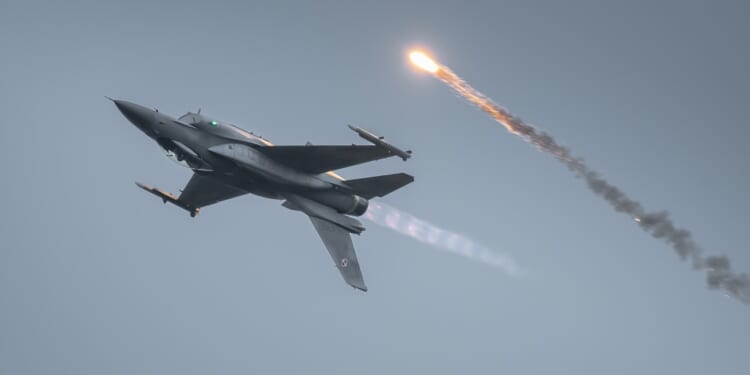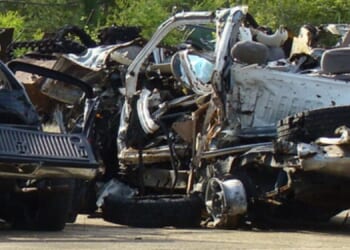ACM training is not about memorizing a catalog of maneuvers, but ingraining a mindset within the pilot: managing chaos, anticipating geometry, and making split-second decisions under high-G pressure.
Modern fighter aviation depends heavily upon beyond-visual-range (BVR) engagements, where long-range missiles, low observability, and sensor fusion promise to end the within-visual-range (WVR) dogfighting era. In other words, given that today’s fighter pilots have access to weapons and sensors capable of engaging enemies from dozens—or even hundreds!—of miles away, it might seem antiquated to put pilots through air combat maneuvering (ACM) training.
Yet across the world’s air forces, ACM remains a cornerstone of fighter training. Why? In short, despite evolving technologies, the physics of close-in engagement are still vital, and because the possibility always exists that a pilot could find themselves in a WVR fight.
Hoping for BVR, Preparing for WVR
Even in a BVR environment, missiles can miss. The elements that maintain a BVR environment—electronic countermeasures, deceptive jamming, terrain masking, or restrictive rules of engagement—can collapse, forcing fighters into a close-quarters fight. And at that moment, stealth coatings and data networks become irrelevant. In such a scenario, only the pilot’s ability to manage energy, geometry, and timing determine survival.
ACM training instills the instinctive responses that determine outcomes when two fighters draw close enough to enter a turning battle. Pilots who cannot fight and win within visual range are incomplete pilots, regardless of how advanced their aircraft may be.
Despite generations of advancement in fighter technology, the core idea behind ACM—get behind the enemy fighter and shoot it down—has been unchanged since the earliest air battles of World War I. Whether in a Sopwith Camel, Supermarine Spitfire, or F-22 Raptor, ACM is all about energy management and angles. Energy is a combination of speed, altitude, and maneuvering potential. A fighter with surplus energy has options: they can climb, dive, or accelerate away, in turn dictating the pace of the engagement. Angles meanwhile refer to the position of an aircraft’s nose relative to the opponent. The pilot who can point their weapons envelope at the adversary, while denying the reciprocal, obviously gains the advantage. ACM teaches pilots to recognize when and how to trade speed for turn rate, or when to widen a circle to preserve energy, or when to cut across an opponent’s flight path to collapse separation—the decisions that dictate survival, which must be made instinctually.
A Fighter Pilot’s Standard Maneuvers
Within the fundamentals of ACM, a core set of maneuvers have become standard. When a pilot is on the offensive, they employ pursuit curves. Broadly speaking, this can be broken down into “lead pursuit,” in which the pursuing aircraft’s nose is aimed ahead of the adversary’s path to close distance quickly, and “pure pursuit,” where the nose is pointed directly at the target. Sometimes, a pilot can also lag the aircraft’s nose behind an enemy aircraft, making a wider turn and preventing them from overshooting the enemy.
On defense, pilots often rely on the break turn—a maximum-G turn into the attacker’s nose that forces the enemy to overshoot if mistimed. Defensive pilots may also employ a “scissors” maneuver—a series of sharp, alternating turns that trade energy for angles in the hopes of flipping roles and gaining an offensive opportunity.
Other maneuvers employ a vertical dimension to exploit energy. For example, the “high yo-yo” involves climbing during a turn, bleeding off excess speed while tightening nose position, before then dropping back into the plane of motion to re-engage. Conversely, the “low yo-yo” dives beneath the opponent to regain energy and emerge with greater closure. A range of other maneuvers—the Immelman, the Split-S, the barrel roll, and the rolling scissors, among many others—build upon the fundamentals of ACM.
Ultimately, ACM training is not about memorizing a catalog of maneuvers. Instead, it is about ingraining a mindset within the pilot. ACM teaches the pilot to manage chaos, to anticipate geometry, and make split-second decisions under high-G pressure. And while dogfighting is disappearing from modern combat, it has not disappeared entirely. So, at least for now, ACM remains a component of the training regime, and a pilot’s last insurance policy.
About the Author: Harrison Kass
Harrison Kass is a senior defense and national security writer at The National Interest. Kass is an attorney and former political candidate who joined the US Air Force as a pilot trainee before being medically discharged. He focuses on military strategy, aerospace, and global security affairs. He holds a JD from the University of Oregon and a master’s in Global Journalism and International Relations from NYU.
Image: Shutterstock / castigatio.

















